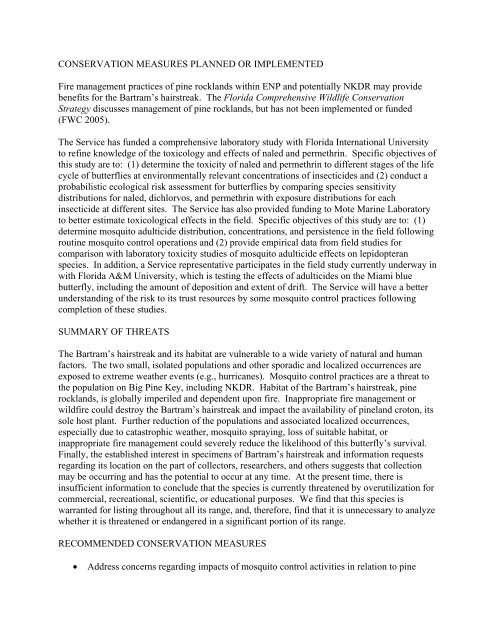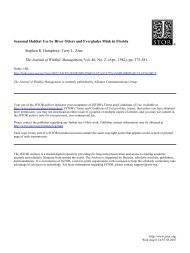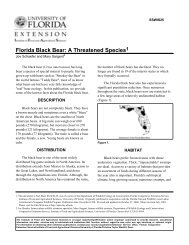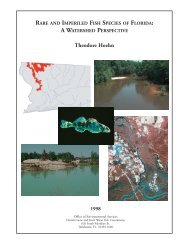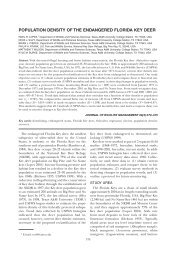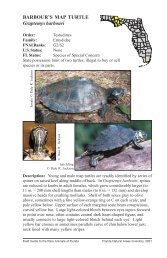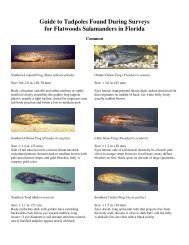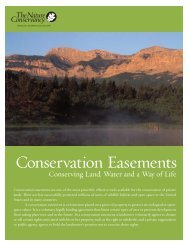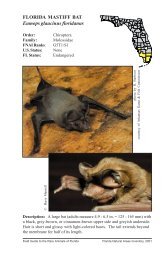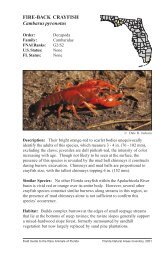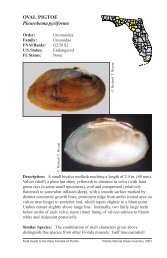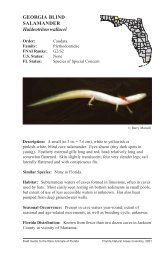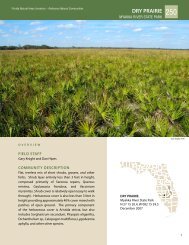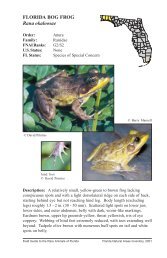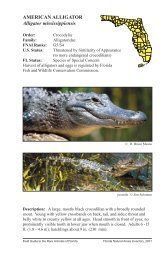Bartram's hairstreak butterfly - Florida Wildlife Conservation Guide
Bartram's hairstreak butterfly - Florida Wildlife Conservation Guide
Bartram's hairstreak butterfly - Florida Wildlife Conservation Guide
You also want an ePaper? Increase the reach of your titles
YUMPU automatically turns print PDFs into web optimized ePapers that Google loves.
CONSERVATION MEASURES PLANNED OR IMPLEMENTED<br />
Fire management practices of pine rocklands within ENP and potentially NKDR may provide<br />
benefits for the Bartram’s <strong>hairstreak</strong>. The <strong>Florida</strong> Comprehensive <strong>Wildlife</strong> <strong>Conservation</strong><br />
Strategy discusses management of pine rocklands, but has not been implemented or funded<br />
(FWC 2005).<br />
The Service has funded a comprehensive laboratory study with <strong>Florida</strong> International University<br />
to refine knowledge of the toxicology and effects of naled and permethrin. Specific objectives of<br />
this study are to: (1) determine the toxicity of naled and permethrin to different stages of the life<br />
cycle of butterflies at environmentally relevant concentrations of insecticides and (2) conduct a<br />
probabilistic ecological risk assessment for butterflies by comparing species sensitivity<br />
distributions for naled, dichlorvos, and permethrin with exposure distributions for each<br />
insecticide at different sites. The Service has also provided funding to Mote Marine Laboratory<br />
to better estimate toxicological effects in the field. Specific objectives of this study are to: (1)<br />
determine mosquito adulticide distribution, concentrations, and persistence in the field following<br />
routine mosquito control operations and (2) provide empirical data from field studies for<br />
comparison with laboratory toxicity studies of mosquito adulticide effects on lepidopteran<br />
species. In addition, a Service representative participates in the field study currently underway in<br />
with <strong>Florida</strong> A&M University, which is testing the effects of adulticides on the Miami blue<br />
<strong>butterfly</strong>, including the amount of deposition and extent of drift. The Service will have a better<br />
understanding of the risk to its trust resources by some mosquito control practices following<br />
completion of these studies.<br />
SUMMARY OF THREATS<br />
The Bartram’s <strong>hairstreak</strong> and its habitat are vulnerable to a wide variety of natural and human<br />
factors. The two small, isolated populations and other sporadic and localized occurrences are<br />
exposed to extreme weather events (e.g., hurricanes). Mosquito control practices are a threat to<br />
the population on Big Pine Key, including NKDR. Habitat of the Bartram’s <strong>hairstreak</strong>, pine<br />
rocklands, is globally imperiled and dependent upon fire. Inappropriate fire management or<br />
wildfire could destroy the Bartram’s <strong>hairstreak</strong> and impact the availability of pineland croton, its<br />
sole host plant. Further reduction of the populations and associated localized occurrences,<br />
especially due to catastrophic weather, mosquito spraying, loss of suitable habitat, or<br />
inappropriate fire management could severely reduce the likelihood of this <strong>butterfly</strong>’s survival.<br />
Finally, the established interest in specimens of Bartram’s <strong>hairstreak</strong> and information requests<br />
regarding its location on the part of collectors, researchers, and others suggests that collection<br />
may be occurring and has the potential to occur at any time. At the present time, there is<br />
insufficient information to conclude that the species is currently threatened by overutilization for<br />
commercial, recreational, scientific, or educational purposes. We find that this species is<br />
warranted for listing throughout all its range, and, therefore, find that it is unnecessary to analyze<br />
whether it is threatened or endangered in a significant portion of its range.<br />
RECOMMENDED CONSERVATION MEASURES<br />
• Address concerns regarding impacts of mosquito control activities in relation to pine


